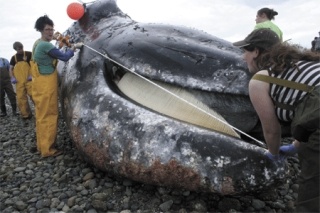A gray whale that was dissected on a Whidbey Island Naval Air Station beach Wednesday afternoon likely died from being struck by a ship in Puget Sound.
Jessie Huggins, a stranding coordinator with Cascadia Research, led the colossal necropsy, with assistance from a team of helpers from Fish and Wildlife, the Marine Mammal Stranding Network and the Orca Network. She found bruising in the animal’s blubber and internal organs, as well as a great deal of bloody fluid inside the whale. The animal also had a stomach full of undigested food, which helps rule out illness.
“Sick animals don’t eat,” she said.
The results of the examination aren’t yet conclusive. Huggins and other researchers took a number of specimens for testing, but results won’t be back for a couple of months.
The 41-foot, 5-inch male wasn’t one of the “regulars” that visit Puget Sound for a snack of ghost shrimp during the annual migration. Huggins said she hopes to identify him with the help of an expert.
The dead whale’s long, strange trip came to an end Tuesday night when a boat from Deception Pass Tour towed the body to the Polnell Point beach, which is a restricted area owned by the Navy.
The dead whale was first spotted at about 9:30 Sunday morning by a Camano Island resident. The woman thought the floating gray whale was alive and emailed Susan Berta of Whidbey’s Orca Network. Soon afterward, another Camano resident called Berta and reported it was a dead whale.
Matt Klope, a member of the Stranding Network, went after the whale with Vinton Waldron, owner of Whidbey’s Seabolt’s Smokehouse. They tried to tow the carcass to the Navy base with Waldron’s crab boat, but the body was too big.
“It was like ‘Jaws.’ We’re gonna need a bigger boat,” Klope joked, quoting the movie.
They finally cut the whale loose near Langley and it beached on a Sandy Point property Monday night, but floated away on the high tide Tuesday morning. The whereabouts of the carcass were unknown until it was spotted in Port Susan, between Camano Island and the mainland, at around noon Tuesday.
This time, Klope used a bigger boat. Brett Ginther of Deception Pass Tours supplied a large vessel for the job, but it still took more than six hours to tow the whale to Whidbey.
Klope said he got permission from the base commanding officer, Captain Gerral David, to bring the deceased leviathan to Navy property, where it can rot in peace. He said David is very supportive of such scientific and multi-jurisdictional efforts.
The necropsy was a whale of a task, requiring grappling hooks and butcher knives that continually needed to be re-sharpened.
Huggins, the lead whale-slicer, cut into the animal and found that the blubber was thick, but the pinkish whale fat didn’t look very healthy to her.
“There are signs of slightly dryer, fibrous blubber, which means it was metabolizing the blubber,” Huggins said.
She explained that it’s not uncommon for gray whales visiting Puget Sound to have blubber in short supply since they fast during much of their migration.
Huggins noted bruising and edema after peeling back the skin and blubber on the whale’s abdomen. The bloated body actually exploded when she punctured the abdominal cavity, flooding the beach with bloody fluid.
“It was quite a shower,” Huggins said.
The outside of the whale body was scraped up from being dragged on rocks, though one flipper had a possible orca bite that had started to heal. The body, and especially the head, was spotted with barnacles and whale lice, which are large, creepy-crawly parasites with spiky claws. Healed scars from the relatively-innocuous parasites were visible all over the skin, which felt and looked a lot like an eggplant.
The internal bloating caused the whale’s behemoth penis to protrude from the body, which became the target of joking among the team. The smell was hardly noticeable until trapped, putrid gas started leaking loudly from the anus.
Yet nobody lost sight of the notion that the gray whale was a magnificent, awe-inspiring creature and that its death was nothing less than a worrisome tragedy. Klope, a biologist, explained that gray whales are unique among baleen whales since they doesn’t use the plates to filter water.
“He’s a bottom biter,” Klope said. “He’s going after the worms and shrimp in the sand and mud.”
The lost-and-found carcass will slowly dissolve into the rocks and sand, leaving only bones behind.
“This will really just melt into the beach. It’s really amazing,” Klope said Wednesday afternoon, standing next to the giant body of the marine mammal.
To help others discover the wonders of the whale, Klope said he hopes to donate the bones and baleen to schools and educational programs, though he wants the oversized skull to go to the interpretive program at Deception Pass State Park.



